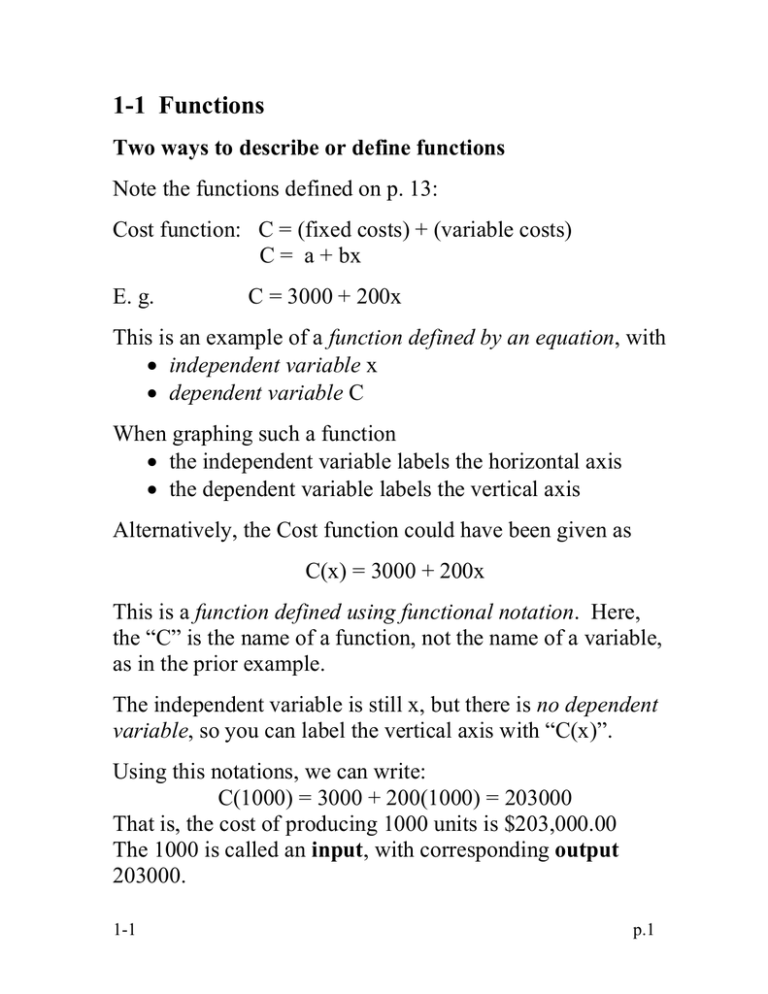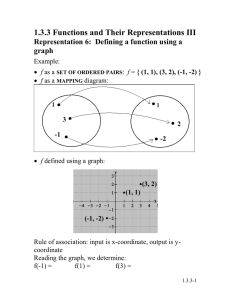1-1 Functions
advertisement

1-1 Functions Two ways to describe or define functions Note the functions defined on p. 13: Cost function: C = (fixed costs) + (variable costs) C = a + bx E. g. C = 3000 + 200x This is an example of a function defined by an equation, with independent variable x dependent variable C When graphing such a function the independent variable labels the horizontal axis the dependent variable labels the vertical axis Alternatively, the Cost function could have been given as C(x) = 3000 + 200x This is a function defined using functional notation. Here, the “C” is the name of a function, not the name of a variable, as in the prior example. The independent variable is still x, but there is no dependent variable, so you can label the vertical axis with “C(x)”. Using this notations, we can write: C(1000) = 3000 + 200(1000) = 203000 That is, the cost of producing 1000 units is $203,000.00 The 1000 is called an input, with corresponding output 203000. 1-1 p.1 Some common business functions (see p. 13) Cost: C = a + bx the cost of producing x items The “parameters” (numbers that are specific to a particular business situation), are a and b. Example: C = 100 + .50x fixed cost = $100 cost per item produced = $.50 Price-demand: p = m - nx x is the number of items that can be sold for a price of $p per item Here, m and n are the parameters that will vary according to the business situation. Example: p = 1 - .0001x: Price Demand Notice that as the price goes up, the demand will drop. 1-1 p.2 Revenue: Revenue will be (#items sold) x (price per item) R = xp where x = #items sold p = price per item Looks like as price increases, revenue increases, right? But as price increases, demand (x) decreases, remember? Two conflicting forces. How do they resolve? For our example: R(x) = xp = x(1 - .0001x) Here’s the Revenue graph for our example: Revenue Demand Note: lowered prices greater demand increased sales BUT the lower prices eventually overtake increased sales, ultimately decreasing revenues. 1-1 p.3 Profit: Profit is, of course, Revenue – Cost: P = R – C For our example: C(x) = 100 + .50x R(x) = x(1 - .0001x) P(x) = x(1 - .0001x) – (100 + .50x) = -.0001x2 +.50x - 100 Here, Profit is written in terms of Demand (x). 1-1 p.4 Guidelines for graphing functions Label and scale your graphs! (1) both axes must be labeled according to the names of the variables given by the problem: independent variable (often “x”) on the horizontal axis dependent variable (often “y”) on the vertical axis if the graph is the graph of a named function, there is no dependent variable; instead, the name of the function is used; e.g. "f(x)", as shown above (2) scaling should be done so as to convey the sense of scale of the graph without overly cluttering it: if the scale goes from 1 to 100, don't draw in 100 ticks and scale each one usually 2-10 scale ticks, with 2-3 of them labeled will convey the scale, as shown above 1-1 p.5

